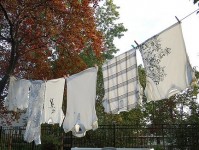Photo: Mike LaconCross-posted from Sightline Daily.
Elizabeth Morris and her family bought their house in Seattle’s High Point neighborhood for a reason. “High Point is the city of Seattle’s premier ‘green community,’ having been touted internationally as such, as well as [for] mixing Seattle Housing Authority [SHA] rental properties and private home ownership,” she explained. It’s a compact, walkable, mixed-income, energy-efficient, green-built neighborhood peppered with bicycle commuters and rain barrels. So Morris was shocked to find that at High Point, clotheslines are banned.
“Homeowners have even been warned that it is illegal,” Morris said. “Not only are owners not allowed to save energy by hanging out laundry, but those who rent from SHA [read: low income] aren’t allowed to save on their energy bills, either.”
Like over 60 million other Americans and Canadians, Morris lives in a neighborhood governed by a homeowners association (HOA). These quasi-private governments, along with some apartment blocks and condominiums, are largely free to set rules as they see fit. Penalties for violations range from fines to forced expulsion. Imagine being banished by your neighbors for drying your clothes!
Clothesline bans are wrongheaded, because line drying’s advantages are numerous. For one, anyone who hang dries will tell you that it makes clothes last much longer — all that lint in your dryer filter has to come from somewhere. Benefits go beyond that, however: according to the Northwest Power and Conservation Council, households in the Northwest states use 4.3 percent of their annual electricity consumption to dry laundry. To put that into perspective, even our refrigerators only gobble up 3.5 percent. As The New York Times highlighted in an article last year, the typical U.S. household could prevent 1,500 pounds of carbon dioxide from entering the atmosphere each year simply by turning off its dryer and hanging out the wash. Oh, and clotheslines never burn down your house; in the U.S. alone, dryers cause more than 12,000 residential fires annually [PDF].
Not everyone has the time to put all their laundry on the line every wash day, but for many Northwesterners, including Morris, overbearing homeowner rules deny them the choice. Examples abound. The Willow Brook Home Owners Association [PDF], in Bonney Lake, Wash., lumps clotheslines with such outdoor undesirables as “litter, trash, junk … broken or damaged furniture … [and] trash barrels.” In the neighborhood of Awbrey Butte [PDF] in Bend, Ore., a clothesline-using mother and nurse garnered national attention, including a spot on the Colbert Report, a few years ago for standing up to her homeowners association when it fined her nearly $1,000 for sun-drying her laundry without approval. Bans do not have to be explicit to be a significant barrier, either: The neighborhood of Forest Heights [PDF] in Portland, Ore. allows clotheslines, but only if they are “completely screened” and “are not visible from any street or adjoining property.”
Sightline found these cases in just a few days of looking. We suspect that many HOA, condo, and rental rules across Cascadia carry the same hidden impediment to solar drying. We need your help to document the scale of the problem. We’ve set up a Google Map to plot out the locations of these pernicious regulations. If you or someone you know lives where clotheslines are forbidden, please help us! Email Editor@sightline.org with the location, name, and text of the rule in question. See the map for examples.
Fortunately, there’s good news in laundry-land. First, air-drying systems have come a long way in sophistication and design elegance: Take a look at this array of options. Second, some states have blasted through outdoor-drying barriers by passing laws that prohibit the banning of clotheslines. That’s right, they’ve banned the bans and enacted a right to dry. Colorado, Florida, Hawaii, Maine, Utah, and Vermont have legalized laundry lines, while Connecticut, Maryland, Nebraska, New Hampshire, North Carolina, Pennsylvania, and Virginia have all considered or passed watered-down versions. Not to be left out, in 2008, Ontario became the first Canadian province to pass so-called Right to Dry legislation (though it exempted condos and apartments). The Oregon legislature has considered, but failed to pass, House Bill 3059, which would amend the rules that govern what can be legally included in property agreements. Another, more circuitous, way to unban air drying is to reclassify clotheslines as solar energy collectors. This redefinition would ensure that existing “solar rights” laws (in effect in Washington, Oregon, and Idaho, but not British Columbia) extend to solar dryers, and not just to solar panels. However it’s done, the key to addressing the issue is to ensure compliance from existing homeowner associations and not just future ones.
In an age of climate change, high energy prices, a down economy, and tight budgets, leaders have few clearer opportunities to help citizens save money while trimming emissions than to legalize clotheslines. And what better place to start than with Elizabeth Morris’ neighborhood — Seattle’s model, green, low-income housing place, High Point?



